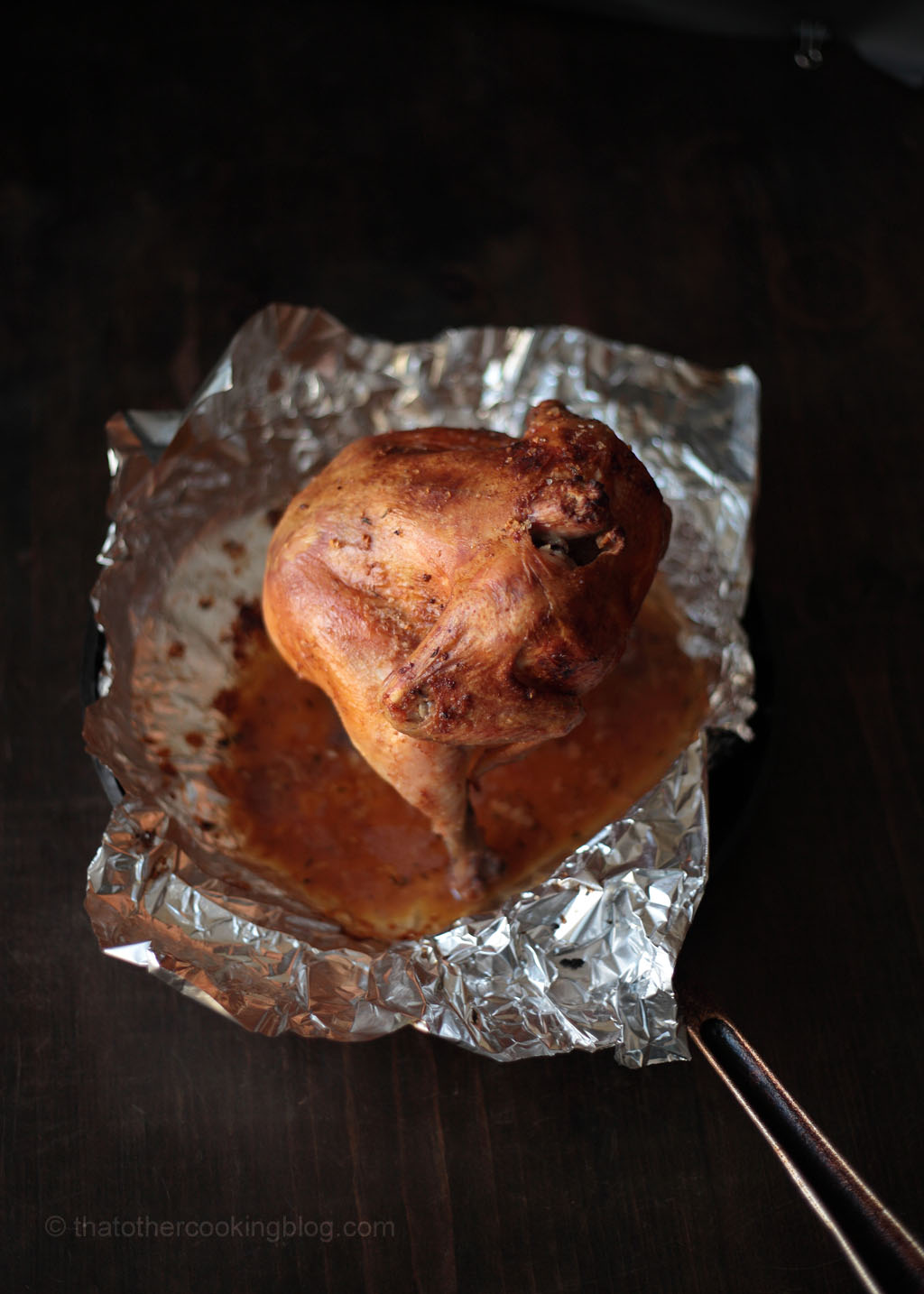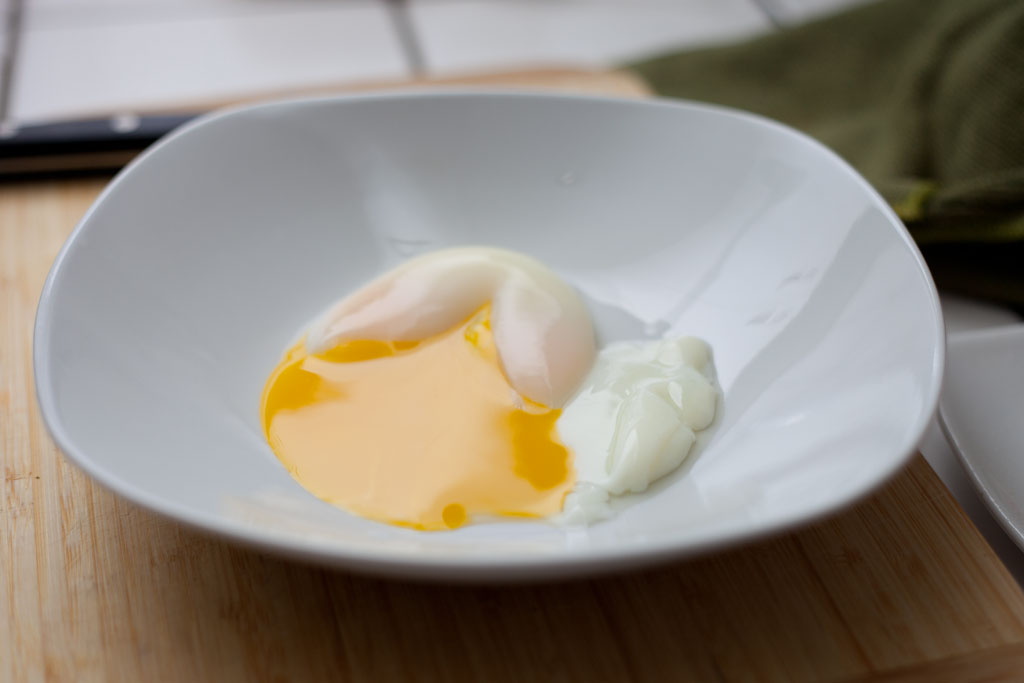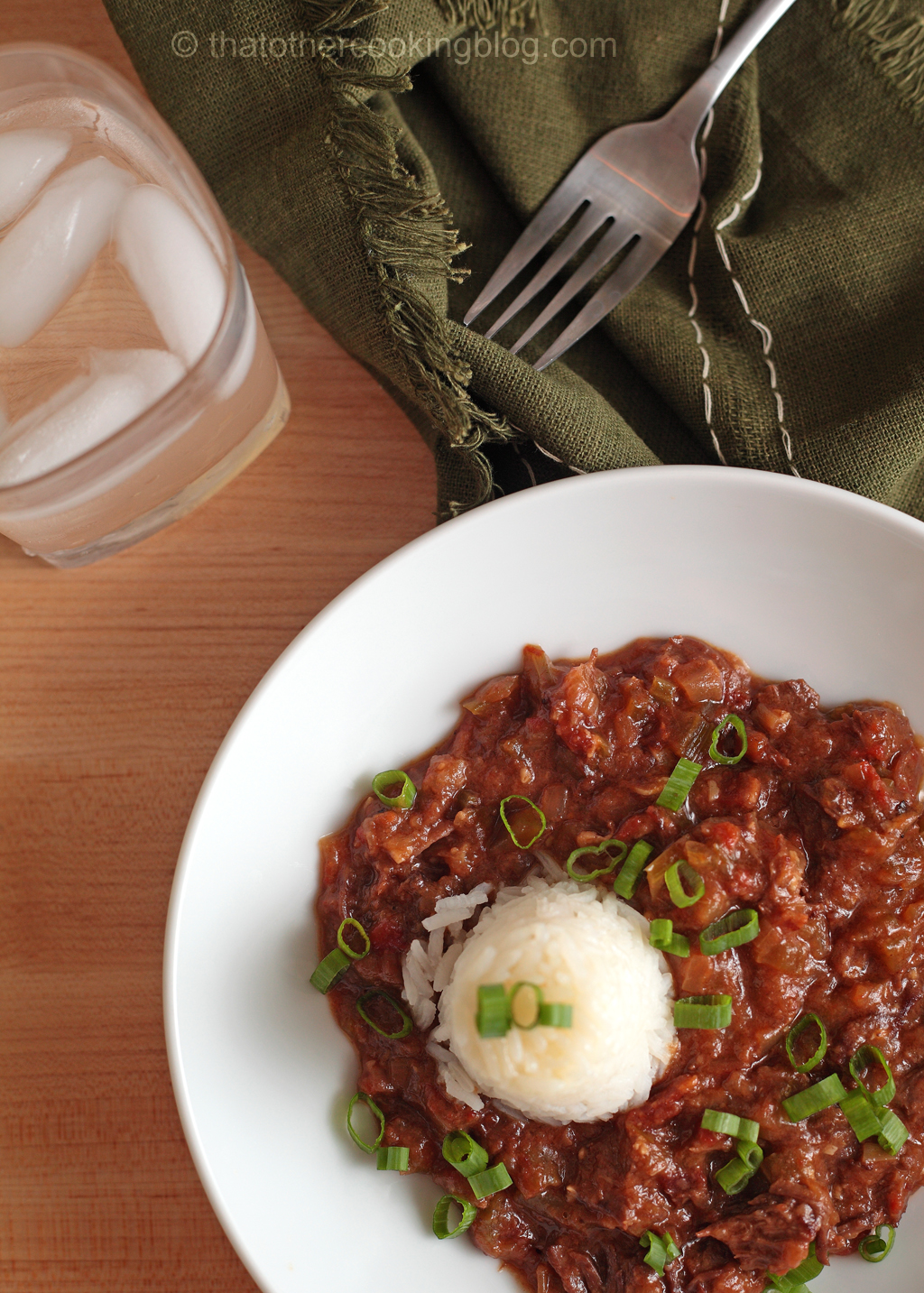Beer Can Roasted Chicken. This is a subject I’ve been meaning to write about for a long time. Roasting a chicken. Roasting a whole bird poses some challenges. Trying to get the right part of the chicken to cook at the right temperature is nearly impossibly as whole. The easy way out and more precise approach would be to portion the bird and cooking it sous vide, but this is not a practical approach when we want results without specialized gear not everybody has at home, immersion circulators, heated water baths.. etc, even if we did it the improvisational way (probe thermometer and pot on the stove), it would still require time and a great deal of attention. But, historically, we’ve been enjoying succulent roasted birds without sous vide. Even with some margin of error, a succulent roasted chicken in the oven is definitely possible with some practice and some tips. Here I have this whole roasted chicken basted in a garlic and thyme butter, delicious!


There are as many approaches to roasting a chicken as there are chefs out there. So we probably need to talk about the things that make a roast chicken a good roast chicken aside from the method. Things we all like. Let’s talk about the requirements here:
1. A roast chicken has to be cooked through, no pink chicken please.
2. A roast chicken has to have flavor inside and out.
3. A roast chicken has to be juicy and tender.
4. A roast chicken must have crispy golden brown skin
A roast chicken has to be cooked through
The temperature at which chicken cooks varies depending on the muscle in question, this is one of the reasons why it is tricky to roast a chicken. Breasts cook in the range of 58ºC-65ºC (136ºF-149ºF) and the dark meat cooks in the range of 64ºC-68ºC (147ºF-154ºF). We could compromise both, and cook the whole bird in the overlapping range which is 64ºC or 147ºF. The breasts will be slightly flakey but still relatively juicy. Most ovens don’t reach temperatures this low, and at this low temperatures would take very long to roast a whole chicken. There is literally no way of not overcooking the bird to some degree if we use a regular oven. Period. But this is not a deal breaker. A chicken will still come out juicy and delicious just not perfectly juicy and delicious.
A roast chicken has to have flavor inside and out
Salting the chicken ahead of time will help get some of that salt infused into the chicken. We will still won’t get enough flavor into the meat just by salting the outside or even the cavity, but sometimes this is enough to get nice results. Add plenty of salt, rub it over and if possible under the skin, into the cavity, and let it rest. I recommend brining the chicken though. If you have time. Prepare a nice brine solution, 7% salt, 3% sugar and submerge the chicken in it (you could add extra flavor by using honey, rosemary, garlic…etc). About an hour per pound. The salt will draw moisture along with the other flavors into the chicken as well, the sugar will help the bird taste better and caramelize quicker.
A roast chicken has to be juicy and tender
This is where overcooking becomes a big concern. Time and temperature will determine this. We talked about temperature before. And we now know that chicken meat requires lower temperatures than those offered by most ovens. Time is also a huge factor determining juiciness. As muscle fibers contract when heat is applied, water is displaced out, and lost. The longer it cooks, the more water is lost. We then have to keep in mind cooking the bird for as long as needed to ensure pasteurization and proper doneness. White meat will suffer more from longer cooking times than dark meat. That’s why chicken breasts dry out so easily.
A roast chicken must have crispy golden brown skin
Ah, the staple of a good roast chicken. The crispy golden skin. Since the only way to achieve this is to draw as much moisture away from the skin as possible so it can be heated enough to cause it to caramelize, a high temperature is required which will cause the rest to overcook a bit. There’s really nothing we can do to stop this. We could cook the whole chicken at 147ºF, then lower its temperature to nearly freezing, and we could then flash fry the skin in a deep fryer. This is probably the only way we could protect the meat from overcooking and the skin to crisp up and go nice and golden. But we are not gonna do that. We will be happy with a slightly overcooked inside. It’s not the end of the world.
So what’s a good way to roast a chicken given all this limitations?
Beer can chicken is no secret to anyone familiar with the ways of the summer grilling activities. As it happens, this grilling technique is actually a fantastic way to roast a chicken in the oven as well. I’ve been roasting chickens for a few years, and without a doubt this technique yields the best balanced distribution of heat to cook the bird in my experience. The breasts face downward, and the skillet shields them from some of the radiant heat coming from the bottom of the oven, which is something we want. I use an empty can of tomatoes, paper removed. More stable and durable. The can is inserted in the cavity of the chicken, and then the whole chicken sits on the can over a skillet that’s been lined with aluminum foil. Pull the legs forward so the chicken is standing on the can and the 2 legs as well. Once your chicken is propped is ready to be roasted. These are some guidelines, I use a probe thermometer to monitor the chicken and adjust times based on what the chicken looks like through the roasting process, so only use as reference:
1. Brine the chicken as instructed above
2. Let the chicken dry in the refrigerator overnight (this mostly dries the skin)
3. Rub the chicken with some fat, the garlic butter or butter, vegetable oil, etc.
4. Preheat oven at 500ºF
5. Chicken cold from the fridge. Roast at 500ºF 20 minutes
6. Brush chicken with garlic butter.
7. Roast an extra 30 minutes at 350ºF
6. Brush chicken with garlic butter.
7. Roast an extra 40 minutes or until done at 200ºF
8. Once out of the oven. Allow chicken to rest for about 30 minutes.
I take the chicken out the oven when brushing it with the garlic butter. Close the oven doors while doing this to keep oven hot.
I’ve roasted the chicken at 450 for 50 minutes and then lowered the temperature to 250 for another 30 minutes which gives me pretty good results as well. If the chicken is at room temperature, it will be harder to brown the skin and not overcook the meat. I’ve gotten pretty good roast chicken that started at room temperature, but the skin never got to crisp up enough. Basting the skin with butter will help getting it golden and crispy.
Here’s another approach to roast chicken by Heston Blumenthal. Removing the wish bone does make carving a lot easier later indeed. I suggest removing it too!

For the garlic thyme butter, well ,yes butter (could be salted butter), some thyme sprigs… use the little leaves only. Salt, I used coarse sea salt, but table salt should work fine if not better. Mix everything together in a bowl and have it ready for brushing your chicken when the time comes!

And that’s it! One thing I want to mention before I go. The juices caught on the tin foil are priceless, do not throw away! They could be used to make an amazing gravy, or flavor a rich wine reduction. Tons of opportunities for creating flavorful sauces. Or just simply drizzle it right over the plated chicken as is. That’s what I ended up doing. Ah! one last thing! the carcass which most times ends up in the trash can is the key to a great homemade brown chicken stock. Keep it! and it also holds the chicken oysters, which I think are the most delicious bites found on a roast chicken. Try them if you haven’t!!! Hope you find this post useful. If you have your own yummy roast chicken technique, don’t hesitate to post a comment. It is an interesting topic everybody interested would like to read about, including myself!

Wanna get more sous-vide cooking guides and cool cooking how-to’s in your mailbox? You know what needs to be done!
We never spam. You should only be getting updates when new content is posted on the site. We also respect your privacy. We don’t share your email address with anyone and you can unsubscribe anytime!





9 comments
I love roast chicken beer can style. Love how you added garlic thyme butter to this. Delicious!
thanks Anne!!! extremely simple to make too!
The garlic thyme butter sounds great! I follow the Thomas Keller roast chicken method, which produces a winner each time. I think part of the secret is in trussing the chicken exceptionally well, as that ensures even cooking.
Thanks Susan! I agree, trussing the chicken is probably a good way to prevent moisture escaping too fast. I’ve seen similar techniques that call for plugging a pierced lemon in the cavity for my guess is… the same reason, plus infusing some lemon taste, but I’ve never really noticed it that much. The beer can approach helps with sealing the cavity too, as the chicken sits right over it, and the steam is trapped inside the chicken (steam will rise up, so perhaps sealing the neck opening would help too). I like the Thomas Keller way shown on Ad Hoc, and it is a beautiful presentation, not to mention, delicious. Thanks for stopping by!!!! 🙂
The chicken looks delicious. The thyme and garlic butter must really enhance flavour. Thanks for sharing this! Have a lovely day!
thank you Liz!!! I hope you try it. You too have a lovely day, and thank you for stopping by 🙂
relink them thoughts